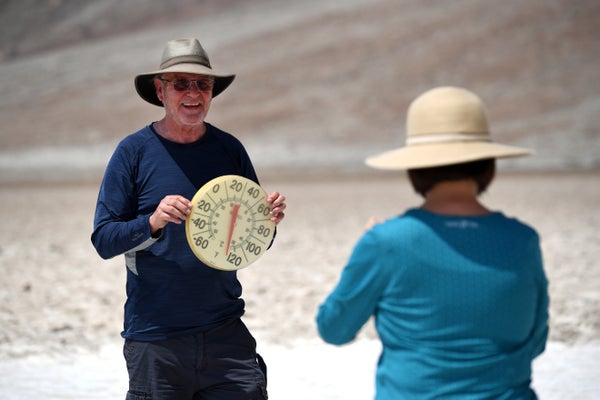Amid a punishing heat wave gripping the U.S. Southwest, Death Valley, Calif., could tie or set the record for the hottest temperature ever reliably measured on Earth.
That record currently stands at a temperature of 130 degrees Fahrenheit set there in August 2020 and again in July 2021. Such heat records are becoming more likely—and record cold temperatures less likely—as the Earth heats up from the greenhouse gases released into the atmosphere by humans burning fossil fuels.
Death Valley, as its name suggests, is sweltering—it’s known as the hottest place on Earth thanks to its desert climate and the local topography. Summer temperatures there often soar past 120 degrees F even in the shade, according to the National Park Service. Because the area’s dry climate is coupled with typically clear skies, the sun constantly heats up the ground, and that heat radiates back into the air. When the air rises, it gets trapped by the steep walls of the valley, which sits 282 feet below sea level. It cools very slightly and starts to descend. As it does so, it compresses and heats up again, making the valley a virtual blowtorch of hot air.
On supporting science journalism
If you're enjoying this article, consider supporting our award-winning journalism by subscribing. By purchasing a subscription you are helping to ensure the future of impactful stories about the discoveries and ideas shaping our world today.
Temperatures in Death Valley could rocket past their usual, already-mind-boggling typical values because of a heat dome that has trapped sizzling hot air over the southern tier of the U.S. Records could also be set in Las Vegas, Nev., Phoenix, Ariz. and parts of Southern California. Phoenix has already seen 14 days in a row with high temperatures at or above 110 degrees F, which is the third-longest such stretch on record. Texas has had weeks of hot, humid weather that has sent the heat index—a basic measure of how hot the temperature feels on your body—spiking into dangerous territory, particularly for young children, the elderly, those who work outdoors and those with existing health issues such as asthma or heart disease. Heat is the number one weather killer in the U.S., causing more deaths than hurricanes, tornadoes and flooding combined.
And the climate emergency is causing a clear trend toward more frequent, longer-lasting and more intense heat waves and more heat records. This past June was the hottest on record globally, according to the National Oceanic and Atmospheric Administration, and the planet likely had its hottest week in human history in the first week of July, according to the World Meteorological Organization.
The WMO, which keeps official global weather records, places the hottest temperature ever measured on Earth at 134 degrees F; this reading was taken in Death Valley on July 10, 1913. This measurement was declared a record in 2012 after a WMO review threw out the previous record of 136 degrees F in Al ʻAzīzīyah, Libya, from 1922 because of issues with the instrument and its placement. Several experts also doubt the legitimacy of the 134-degree measurement because it has similar issues as the Libya temperature reading, however.
The WMO will need to verify any record-high reading from Death Valley, but if it is verified, it would be one of the hottest temperatures ever measured on Earth and the hottest ever reliably measured—though there are decent odds that another heat wave in the not-too-distant future will best it.
